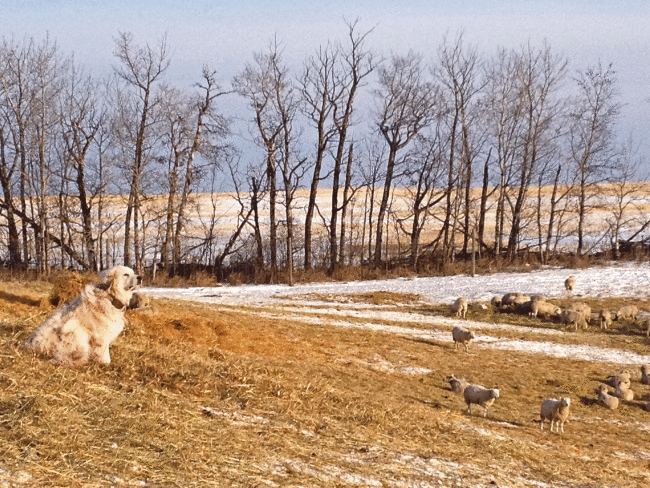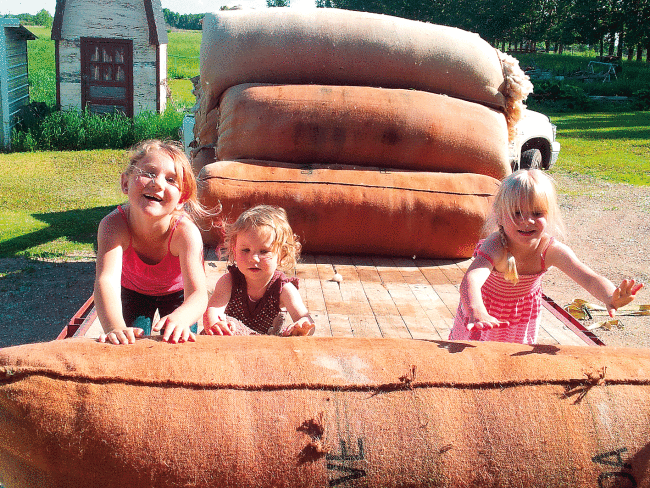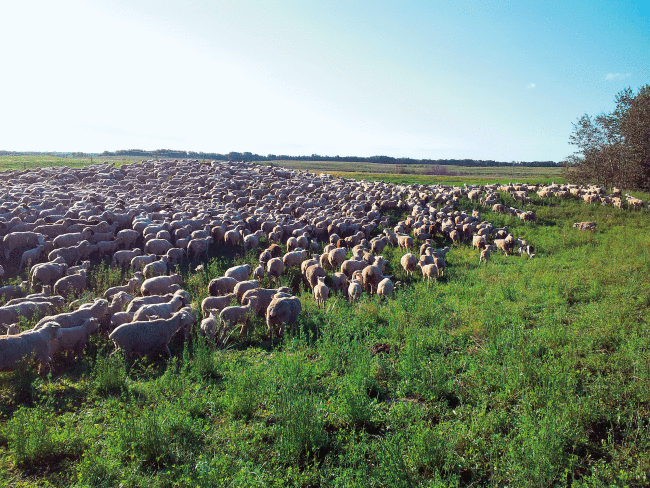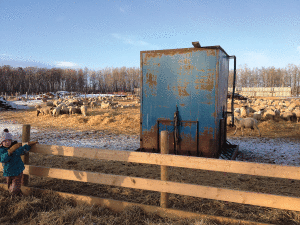by Stuart Chutter

Photo by Stuart Chutter.
Driving down a rural township road searching for the Candll Ranch, I knew I had arrived when I came across a postpounder, wire and a giant stack of fresh, green posts – sure signs of a growing sheep ranch.
Candll Ranch is the home of Cody and Liesl Lockhart, and their daughters Lucy, Jessica and Piper. The Lockharts manage a flock of 1,200 commercial ewes, as well as a herd of 500 cows, using a grass-based approach.
The family came to northwest Saskatchewan five years ago to manage a satellite cattle ranch owned by Cody’s parents. When the opportunity to purchase the ranch came up shortly after, sheep were their first choice for stocking the land. The ewe flock is largely made up of Cheviot and Clun Forest breeding, in keeping with their extensive approach to livestock production.
The ranch is managed with holistic principles; people, land and profit are the three priorities that influence decision making for the Lockharts. Balancing hard work with family time, improving the health of the land and its grass, and running a profitable business are the guiding themes for the operation.
The local ranching community is rich in holistic management philosophies. The PAR Grazing Club meets every two months and organizes grazing tours, speakers, instructors, and workshops to help ranchers achieve their personal and business goals. The last meeting featured a strategic planner to help develop measurable goals specific to each ranch. Group tours have included water systems, corn grazing and even a stop at an Alberta sheep dairy. The philosophies and learning opportunities from this group have been instrumental in the development of the ranch. Cody now considers grass management as the couple’s strength, and their competitive advantage in sheep production.

Balancing hard work with family time is another priority (Lockhart family photo).
When Cody and Liesl first arrived in Saskatchewan, they purchased all of their winter feed from local hay producers. The ewe flock was bale-grazed on three quarter-sections of pasture land for the first three years. However, as grain prices increased over that same time period the hay land was transitioned into crop production, forcing Cody to look for alternative winter feed.
Standing green feed, along with swathed cereal crops, have been used to replace the lost hay supply and reduce yardage costs. But the heavy snowfalls typical of northern Saskatchewan have a tendency to bury any remaining swaths in deep, crusted snow by the end of December. In an attempt to extend the grazing season into January, the Lockharts planted corn in the spring of 2014, and are optimistic about its possibilities for their winter grazing program.

Extending the grazing season as much as possible is a priority at Candll Ranch (Lockhart family photo).
When hay is required in the late winter to early spring, large round bales are partially unrolled directly on pasture. A hay wagon delivers several days’ worth of feed at a time, which can be strategically placed for any desired pasture rejuvenation. Oats are fed only for a short pre-breeding flushing period. With the heavy tree cover in Saskatchewan’s north, ewes have ample natural shelter and wind protection. During any severe weather, feed and straw for bedding are placed directly at these natural shelters. This feeding strategy helps control winter yardage costs, as the tractor is not required daily and there is minimal need for manure spreading from the yards.
The Lockharts’ holistic approach to grass management is also evident in their approach to predator control. Along with a significant local coyote population, the Candll Ranch is only 15 miles from the border of Prince Albert National Park and its resident pack of collared wolves. The first flock of 100 ewes that Cody and Liesl started with five years ago grazed the ranch without any losses to predators for about six months, when the first lamb was killed by a coyote. Once that initial taste was established, the losses were devastating. Cody calls it ‘clockwork’ how those coyotes, who knew the routine of the sheep, would pick off a lamb every morning. The emotional and financial toll on the Lockharts was overwhelming, as it is for any shepherds struggling with predators.
There were no dogs with the sheep at that time and so a mature Great Pyrenees was obtained, followed by a Maremma and two Anatolian Shepherds. Although these dogs were a deterrent and did make a difference, the losses continued. After doing some research and networking on the internet, the Lockharts imported two Kangal dogs from Montana and the losses stopped immediately. The white dogs (Pyrenees and Maremma) and the Anatolians, who had previously been overworked with the pressure from the coyotes, were relieved with the new help and their confidence levels surged. The Kangals were the right fit for a confident mixed pack that could appropriately address the predator situation on the ranch.

One of the Kangal dogs imported from Montana (Lockhart family photo).
The white dogs still have a place on the Candll Ranch, as they bond tighter to the sheep and will remain with the flock while the Kangals are out covering territory. But Liesl suggests that a reliable working instinct is difficult to find in Pyrenees puppies, due to show standards and non-working breeding, making the performance of a white dog puppy more of a gamble.
With the addition of the more active and aggressive Kangal dogs came new challenges and difficulties. The Kangals cover significant ground and are unaware of property lines. Liesl makes great efforts to educate the neighbours on how their dogs behave, as well as making sure they understand her willingness to come get the dogs at any time if they are on their property.
They also offer to pay for spaying and neutering their neighbours’ dogs, in an effort to deter dogs from roaming when females are in heat. Hunting is also a risk; during the hunting season each dog is numbered with a bright spray marker so that hunters can tell them from game or coyotes. Liesl is also looking to add a thick vinyl reflective strip to their collars.
Each dog is protected with a spiked collar. Injuries and vet bills were becoming too common, both from predators as well as from fighting within the guardian dog group. A spiked collar ensures that any fighting among the dog pack does not escalate. This is especially important for the white dogs, which do not have the size and aggression of the Kangals.

A PVC pipe yoke is lighter and less irritating on the neck than one made from wood, but still works to reduce fence crawling (photo by Stuart Chutter).

This spiked collar provides protection for the guardian dogs (photo by Stuart Chutter).
Although the Kangals have been a tremendous addition to their predator management, Cody still considers them only part of the solution. Prudent deadstock removal and being out with the livestock play a major role. In keeping with holistic philosophies, for Cody and Liesl it is not about eradicating the coyote population, but rather keeping them away from their sheep and providing them with incentives to find food elsewhere.

Cody, Liesl, Lucy, Jessica and Piper Lockhart (Lockhart family photo).
Prior to ranching in Saskatchewan, Cody worked in construction in Alberta. This skill set will help the Lockharts with the next phase of their ranch goal – building a new 60’ x 120’ lambing barn. Cody and Liesl plan to move from pasture lambing to barn lambing in order to intensify their lambing process for a larger, more consistent and higher-quality lamb crop. The move will also allow for RFID data collection and improved culling, selection, and genetic decision-making. Modelling their plans after other successful prairie lamb producers, the Lockharts look to increase revenues through intensive lamb management while maintaining relatively low ewe maintenance costs through their extended grazing practices.
For the past several years, lambs have been marketed as feeder lambs straight off grass. Before that, an effort was made at direct marketing, but the time commitment required was too much of a trade-off on time spent managing the livestock and land.
Cody has served on the Canadian Lamb Producers’ Cooperative (CLPC) board of directors and the coop will be incorporated into their marketing plan for 2014 and going forward. A feedlot pen was built at the home farmyard and this year’s lamb crop is now on feed. The first pen is a temporary one made from wood, so that they can find improvements and learn more before investing in permanent facilities. This year will be the first where lambs are finished on-farm rather than marketed off grass. The initial membership shares of the CLPC only allow a percentage of the lamb crop to be sold through the coop. The Lockharts plan to look at future investment shares to allow them to increase marketing by that route, so that lambs can be shipped in larger loads for manageable transport costs.

The Lockharts have several of these self-feeders, purchased from a hog operation for use in the lamb feedlot (photo by Stuart Chutter).
Since stocking the ranch with sheep five years ago, the Lockharts have assembled the components of a productive sheep operation. Cody and Liesl look to 2015 with optimism – when intensive lamb production, low ewe maintenance cost, extended grazing, controlled predators, and a well-defined marketing plan will all come together.
Stuart Chutter is a commercial sheep and meat goat producer living near Gull Lake, Saskatchewan.





